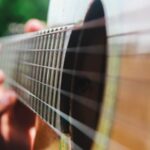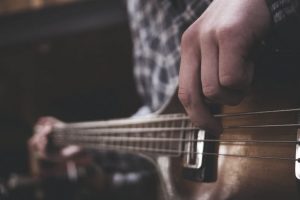Not all guitarists like fanned fret guitars. But many prefer to play them because the fret angles naturally follow the angle of the fingers as you play. What exactly is a fanned fret guitar?
A fanned fret guitar is also known as a multiscale guitar. It features a fretboard with angled nuts which is noticeably different from the perpendicular fret of a traditional guitar. The frets of a fanned fret guitar are on a calculated angle, providing each string with a different scale length.
Read on to learn more about fanned fret guitars, including their advantages and disadvantages.
Fanned Fret Guitar [All about Fanned Frets]
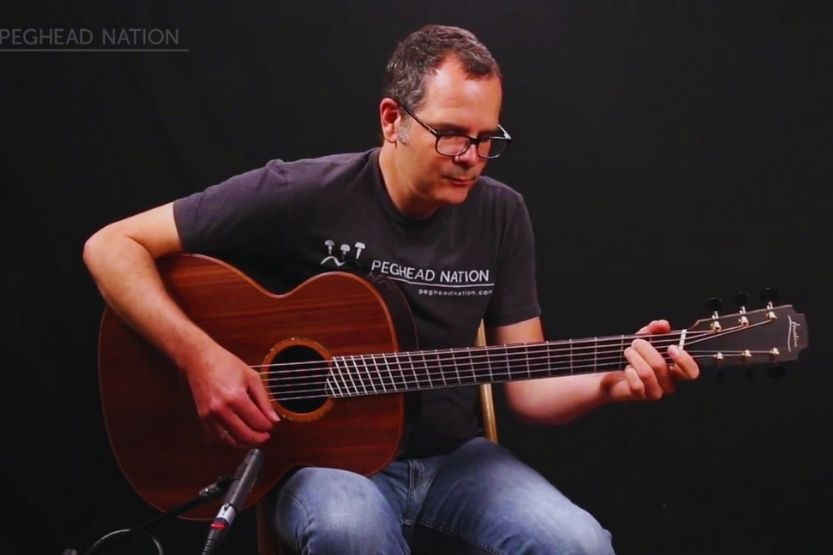
A fanned fret guitar is also commonly known as a multiscale guitar. Its fretboard features angled nuts which are noticeably different from the perpendicular fret of a traditional guitar.
The frets of a fanned fret acoustic guitar, or any other fanned fret guitar for that matter, are on a calculated angle, providing each string with a scale length that varies from one another.
In essence, the idea of fanned frets is to combine the regular guitar with the baritone or bass guitar all in one instrument. Through fanned frets, the tones of the lower strings are strengthened by providing them with a longer speaking string strength.
At the same time, fanned frets can tune a high string to an even higher tone which can’t be done on a regular guitar. A fanned fret is capable of this by providing it with a shorter vibrating length. This allows a string with a higher tune to sound perfect without breaking under the tension.
Fanned Fret Guitars’ Scale Length
A traditional electric guitar may have 6, 7, or 8 strings that share the same scale length. Indeed, you are aware that not all scale lengths are similar. For instance, the scale length of a Gibson Les Paul guitar measures 24.75 inches. At the same time, the scale length of a Fender Strat guitar measures 25.5 inches.
At the same time, there are shorter and longer scales. For instance, children’s guitars have a scale length of 22 inches, while baritones have a scale length of 27.7 inches.
The scale length plays a vital role in terms of string tension, tone, and more.
Brief History of Multiscale Fretted Instruments
Fanned Fret Guitar’s Concept Is Not New
The concept of fanned fret guitars or multiscale instruments is not new. The piano was invented in the early 1700s, while the harp was born in 2500 BC.
Orpharion
Let’s now briefly talk about the history of multiscale instruments through the Orpharion.
The Orpharion refers to a plucked stringed instrument from the Renaissance and is an ancestor of the guitar. Its bass strings are longer than the regular guitar that we have always been familiar with. In essence, its frets can be described as definitely “fanned.” However, a patent for this type of fretboard was only filed in the 1900s.
Advantages of Multiscale Instruments
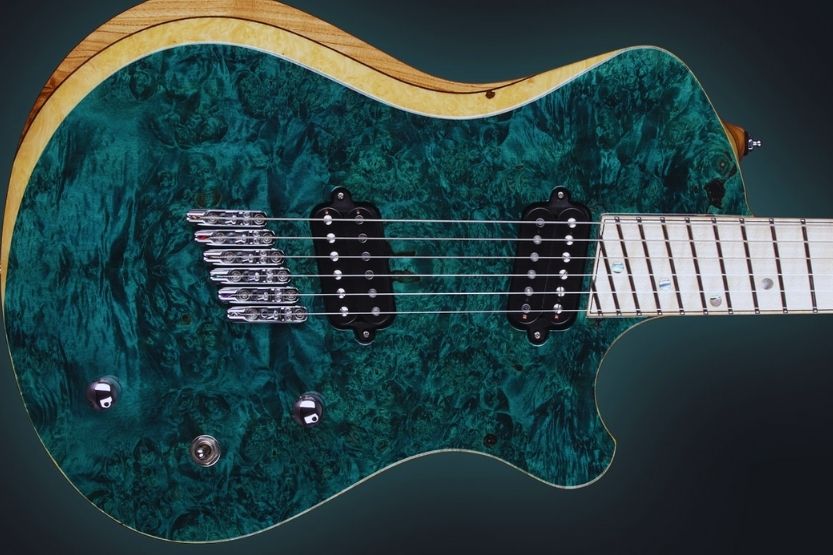
Playing a fanned fret acoustic guitar or any other multiscale instrument has several advantages. These include the following:
- Scale Length Has an Impact on String Tension
- Tone Is Correlated to Scale Length
- Scale Length Affects the Distance Between the Frets on the Guitar’s Neck
- Tuning Stability and Intonation Are Correlated to Scale Length
- Ergonomics
Let’s briefly discuss each one of them:
1. Scale Length Has an Impact on String Tension
When the scale length is longer, a certain string gauge becomes tighter or tauter when in tune.
Let’s compare a .017-gauge G string on a Gibson Les Paul guitar with a scale length of 24.75 inches and a Schecter 7-string guitar with a scale length of 26.5 inches. The string on the Gibson Les Paul guitar is looser than the Schecter one. Suffice to say that the string on the Les Paul guitar will be easier to bend than the one on the Schecter guitar.
2. Tone Is Correlated to Scale Length
Loose String Will Have a Cool Sound
A loose string may undoubtedly have a cool sound. However, it can sound lifeless or flaccid, like if you tune down a guitar with a scale length of 25.5 inches to B. It can result in a dull and undistinguishable sound.
Low-tuned Strings Sound Better With Longer Scales
Thick and low-tuned strings sound better on guitars with longer scales. The reason is a scientific one and has something to do with frequency and vibration. In essence, a string with a lower pitch has a lower frequency and a longer wavelength.
Achieve Low-frequency Notes With Longer Strings
Suffice to say that if you want to achieve flawless low-frequency notes, your guitar must have longer strings. This is the reason why bass guitars have a longer scale length than regular guitars. The low string of bass guitars is tuned down to B or even lower. A good example of this is a Fender P Bass guitar with a scale length of 34 inches.
Higher-pitched Strings Sound Better on Guitars With Shorter Scales
It is then logical to say that higher-pitched strings sound better on guitars with shorter scales. Longer scale length results in harsh sounds instead of rich and full sounds of high notes.
3. Scale Length Affects the Distance Between the Frets on the Guitar’s Neck
The scale length has a big impact on playability. Let’s say, for instance, you are using an Epiphone SG guitar with a scale length of 24.75 inches.
This will make it convenient for you to stretch your fingers as you play “Beat It” by Van Halen. Eddie Van Halen moves from the 12th fret to the 19th fret on the high E and B strings. This can be challenging if you use an ESP baritone with a scale length of 27 inches.
4. Tuning Stability and Intonation Are Correlated to Scale Length
Impossible to Play a Guitar With a Regular Scale Length While Tuned Down
If you haven’t tried, it’s quite impossible to tune and play a guitar with a regular scale length and is tuned down. Try playing the guitar with a scale length of 25.5 inches and is tuned down to B (B, E, A, D, F#, B).
Even if your guitar has thick strings, it’s quite impossible to keep them in tune. The low strings are loose and go sharp on the first impact when picked too hard.
Tuning and Intonation Improve When You Use a Guitar With a Longer Scale Length
If you use the same tuning on a baritone with a scale length of 27 inches, the result is different and far better. However, doing a solo is not fun because bending strings will feel a little odd. At the same time, there are wide-stretch runs that are quite challenging to do.
In simpler terms, tuning and intonation improve when using a longer scale length and with thick and low-tuned strings. For thinner high strings, it is best to use a guitar with a shorter scale length.
5. Ergonomics
Fanned fret guitars have an impact on ergonomics or the way your fretboard hand naturally moves.
Typically, we are all initially taught, programmed, and conditioned to move our fretboard hand perpendicularly across the guitar’s neck. This way, our fingers are positioned at a right angle to the strings, similarly to the frets.
Such a position feels comfortable, particularly in the middle of the guitar neck. However, it becomes less comfortable nearer to the nut. Then, it becomes even less comfortable as you traverse the higher regions of the fretboard.
The fretboard hand’s wrist is forced to rotate away from the central line of your body. This is called supination. Unfortunately, this can become uncomfortable. It is more comfortable to rotate your wrist towards the centerline of your body. This is what we call pronation.
Easier to Rotate Your Wrist Using the Pronation Movement
In essence, it is easier to rotate your wrist using the pronation movement than using the supination movement. With supination, movement is extremely limited.
This is most likely why we see guitarists who prefer to play with rotated guitars. That way, the neck becomes almost vertical when they are soloing higher on the fretboard. This enables them to pronate their wrist and play faster, and do shredding more comfortably. Some famous players who do this are Slash and Zakk Wylde.
Again, what are fanned fret guitars? Fanned frets or multiscale guitars have frets on a calculated angle. As a result, each string has a different scale length. This also results in greater string tension and a comfortable feel for the guitar player.
Disadvantages of Multiscale Instruments
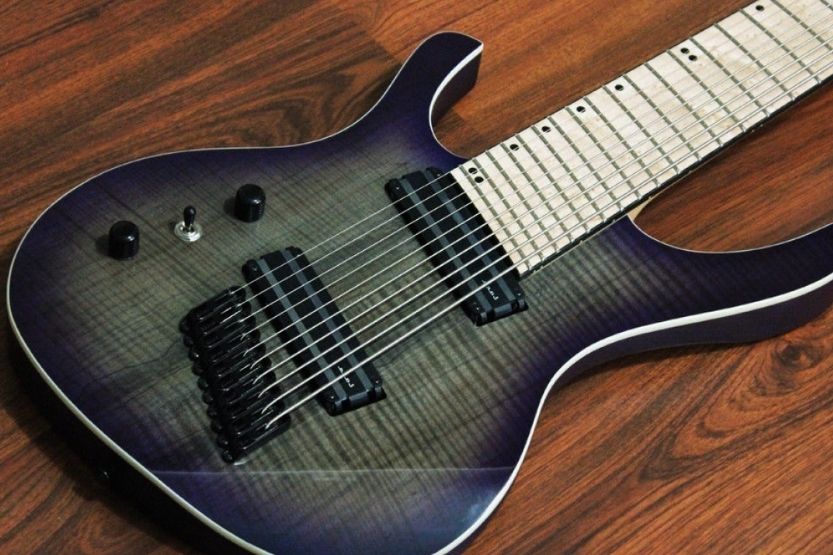
Of course, if there are advantages, there are also disadvantages. Here are two disadvantages that I have gathered from several guitarists:
- Fanned Fret Instruments Are Costly
- Multiscale Instruments Are Challenging to Learn
Let me briefly explain this:
1. Fanned Fret Instruments Are Costly
While the concept of fanned or multiscale instruments is not new, the fanned fret guitar is relatively new in the market. Suffice to say that its market is still not huge.
This logically means that if there’s a low demand for the product, it translates to higher costs. It is more costly compared to the regular guitar models. Also, since it is not yet widely available, you might end up in the custom market, which is even more costly.
2. Multiscale Instruments Are Challenging to Learn
Some players claim that fanned fret guitars are more challenging to learn compared to regular guitars. It may take you some time to get used to the bar chords.
But then, in my honest opinion, it is not difficult to learn it. Besides, if you are determined to learn how to play it, you will surely get used to it fast, no matter how challenging it may be.
Fanned Fret Guitars – Getting the Best of Both Worlds?
In essence, fanned fret guitars offer players the best of both worlds when it comes to scaling. This is because the highest and thinnest strings have the shortest scale length. At the same time, the lowest and thickest strings have the longest scale length. This mixes and matches tonal and playing advantages.
With a fanned fret guitar, you get to bend and shred on the high strings conveniently and flawlessly. As for its low strings, you get to achieve its full sound too.
Tips for Buying a Fanned Fret Guitar
Here are two key factors that you might want to consider before buying a fanned fret guitar:
- Scale Lengths May Differ
- Position of the Straight Fret
1. Scale Lengths May Differ
When checking out fanned fret guitars, examine the scale lengths of the lowest and highest strings since this characteristic varies from one manufacturer to another.
For instance, the Strandberg Boden Metal seven fanned fret guitar models feature scale lengths ranging from 25.5 inches to 26.25 inches. At the same time, the Jackson X Series Dinky DKAF7 fanned fret guitar models have scale lengths featuring from 25.5 inches to 27 inches. The Ibanez RGMS7 fanned fret guitar has the same scale lengths as the Jackson.
2. Position of the Straight Fret
You must also take into consideration the position of the so-called straight fret. The straight fret is also commonly known as the neutral point. It is the one that is perpendicular to the guitar strings. At the same time, all the others around it fan away in both directions.
There are fanned fret guitars in which the neutral point is positioned around the 7th fret. But there are also those positioned as high as the 12th fret. You must remember that the position of the straight fret also affects the way the fretboard plays and feels.
Conclusion – Fanned Fret Guitar
A fanned fret guitar is also popularly known as a multiscale guitar. Its fretboard features angled nuts, which noticeably differs from the perpendicular fret of a traditional guitar. The frets of a fanned fret acoustic guitar, or any other fanned fret guitar for that matter, are on a calculated angle. They provide each string with a scale length that varies from one another.
This type of guitar offers you the advantages of different scale lengths while eliminating many of its disadvantages. If you want a versatile guitar that can flawlessly reach the lowest of low notes and the highest of high notes, you have to go and try playing a fanned fret guitar.
Related reading:
What Does a Compressor Pedal Do?
What Is the Difference Between Acoustic and Electric Guitar Strings?
What Are The Differences Between Four and Five String Bass Guitars?
What Are the Differences Between a Bass Amp and a Guitar Amp?





